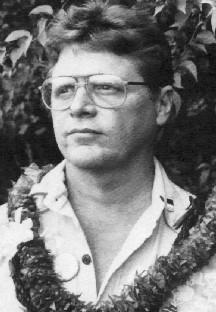Digital Collections
Celebrating the breadth and depth of Hawaiian knowledge. Amplifying Pacific voices of resiliency and hope. Recording the wisdom of past and present to help shape our future.
Robert Lokomaika‘iokalani Snakenberg
Lokomaikaʻi Snakenberg, a paionia (“pioneer”) Hawaiian language teacher at Kailua High School in the 1970s and 80s, composed “Mekila e nā ʻIwa” as a mele hula hoʻi (an “exit dance”) for a Kailua-based hālau to use in the 1984 Merrie Monarch Festival. His mele describes the gathering of ʻiwa above Kawainui pond, their drinking of water there, and their return "to the sea at full tide." It is readily apparent that the mele was written after careful study of the imagery, movement pattern, and meaning of the traditional entrance and exit hula "Hoʻopuka e ka Lā ma ka Hikina" and "Hoʻi ē, Hoʻi lā." The arrival of “Mekila’s” ʻiwa, like those in "Hoʻopuka," captivates our attention and wraps us in wonder; their association with life-sustaining Kawainui echoes the "let there be life for all" sentiments of "Hoʻopuka," and their return to the sea by way of Mahinui’s updrafts echoes the return, in "Hoʻi ē," of the beloved mists to their upland home. Both traditional compositions emphasize bird and mist as messengers of a higher love whose presence serves to lift us out of our petty lives and inspire us to dwell always "where love sprouts and grows." "Mekila e nā ʻIwa" concludes with a similar emphasis: the ʻiwa of Kawainui are not caught up in lesser emotions; they are one at Waialoha. The mele’s kaona rests in these last two lines: don’t dance to compete, dance for love. Loko has since passed away; his mele is published here, for the first time, with the permission of those for whom it was written.
Mekila e nā ʻiwa e kakaʻi ana
I ka māpumāpu iho i ka ʻiliwai
I Kawainui makahehi i ka iʻa
A huli aʻe e kīkaha i ka holouka
I luna aʻe hoʻi o ka Mahinui
E hohoʻi aku ana i ke kai ulu.
He ʻiwa ʻole naʻe hoʻohae nāulu,
Hoʻokahi nō kaunu pū i Waialoha.
Handsome are the ʻiwa flying in formation
Swooping down to the water’s surface
At Kawainui which is so attractive to fish
They turn upward and soar on the updrafts
Up above Mahinui Ridge
Returning back to the sea at full tide.
These are not lovely ones stirring up envy,
For there is only love at Waialoha.
© Robert Lokomaikaʻiokalani Snakenberg, 1984

photo courtesy of: Bess Press
Robert Lokomaikaʻiokalani Snakenberg, keiki hoʻokama of Tūtū Noah Kepoʻikai Spencer and, later, of Kupuna Lilia Wahinemaikaʻi Hale. Snakenberg, he haole piha, never once took advantage of his hoʻokama status by laying claim to the genealogy of his adopted people, nor did he seek to undermine their entitlements, trusts, and institutions. Instead, he devoted himself to the education of Hawaiian children in their own language and culture. He was, among other things, the 1978 Hawaiʻi Teacher of the Year.

photo credit: Kīhei de Silva
Auntie Irmgard Aluli and “Loko” at a 1976 Kūhiō Day celebration at Kailua District Park. The two friends collaborated in the composition of “E Pili mai ʻOe Iaʻu,” the Haku Mele winner of the 1986 Nā Hōkū Hanohano awards.